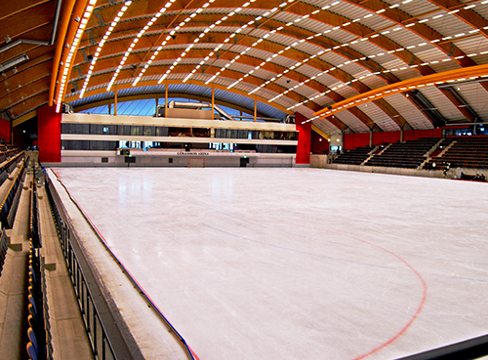Acoustic barriers

Acoustic barrier Drottningsholmsvägen Bromma.
Acoustic barriers should be designed to fit in with the local setting, taking account of the road’s height and route through the landscape, the acoustic requirements and the terrain.
Wood is a suitable material for acoustic barriers because it is light, strong and formable. Acoustic barriers in wood can also be tailored to most environments.
Here are a few considerations when designing acoustic barriers and examples of how they can make use of wood.
Local setting & traffic
Acoustic barriers are part of the public space. Planning and design should pay the same attention to the aesthetic expression and the interplay with the surroundings as with any other construction project. Aesthetic and design expertise must therefore be brought to the process in the early stages of the initial concept and later in the planning and detailing. It is also important to ensure durability through material choices, stable foundations and good maintenance routines, issues that also have an aesthetic component.
Local setting & traffic
Acoustic barriers must be designed to take account of road safety and the landscape. The key rule is that acoustic barriers should be designed as part of the natural and built environment, and less as part of the road. An in-depth analysis of the local setting is thus necessary, looking at factors such as the buildings, the landscape and the road space.
For local residents, the acoustic barrier might obscure the view, but it also keeps the traffic out of sight. For road users, a road with acoustic barriers can seem like a monotonous corridor that reduces contact with the surroundings. In order not to have a negative impact on road safety, long acoustic barriers should therefore vary in their appearance and distance from the road. Acoustic barriers close to the road reinforce the road’s own linear structure and barrier effect. If the barrier is close to the road, it doesn’t need to be as high, but it has to be long enough to screen off the noise. When screening an individual building, it can be better to place a high and short barrier closer to that building. Alongside rail lines, a very low barrier is sometimes placed right next to the tracks.

Acoustic barrier Lahäll.
Look & aesthetics
Acoustic barriers are generally quite a dominant feature of their setting. Choice of material, detail design and colour are crucial for the overall impression that the acoustic barrier gives. Factors such as tailoring to the setting, the landscape, the road space and the need to visually break up lengths of barrier must be taken into account during planning. Solutions based on glass can also help to reduce the sense of a dominant barrier and also retain the view.
It is important to bear in mind that an acoustic barrier has two sides, one for the road users and one for the residents – which should inform the design. On rail lines, the side facing the train passengers is, however, less important. On the road users’ side, the acoustic barrier should be varied, but at the same time given a sense of overall scale that keeps the road users from being distracted. Road users move quickly and don’t register the details in the design. Work on the details is, on the other hand, important for the side facing local residents, as they are more slow-moving and closer to the barrier. Carefully considered solutions for the ends and ridge of the acoustic screen are essential for a successful result.

Acoustic barrier Ekerö and Hässelby.
Vegetation along the acoustic barrier
Vegetation around the acoustic barrier has a major impact on how it is perceived by road users and local residents. It has little effect on sound damping, however. The vegetation can reduce the dominant position that a roadside barrier can have. Depending on the climatic conditions, the barrier may come to be more or less completely concealed after a few years.
Level differences
Level differences caused by sloping ground along the barrier or a need for the barrier height to be varied for acoustic reasons can be dealt with in a variety of ways. The top edge of the barrier should generally follow the height of the road, while the lower edge follows the terrain. Adapting the barrier height to the existing terrain is particularly necessary next to older built environments, where changes to ground levels are not desirable.
The simplest and most common way of accounting for level differences is to step the top and bottom edges of the barrier. With high steps, a concrete foundation is recommended, as this is able to cope with greater height differences than other technical solutions. Stepping is generally most appropriate for moderate slopes, but a sloping ridge can give a smoother look on a steep incline.

Acoustic barrier Berg.
Directional changes
Directional changes are usually made at the posts. Small changes in direction, for example as the barrier follows the road through the landscape, can mostly be handled without any special measures. Corners, particularly those that are not right angles, require a considered technical solution to avoid the need for adjustment work on site and barrier components of special dimensions and design.



